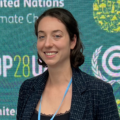Knowing the Different Kinds of Presentations at NACW
For over two decades, NACW has been providing climate professionals with access to the latest information and updates on carbon markets and climate policy. There are two ways to learn and share content – workshops and sessions.
All workshops are scheduled for the first day of the conference. They may feature different formats and be hosted by organizations besides the Climate Action Reserve. At NACW 2024, registered attendees may attend any workshops that are included in the NACW program. Please note that registration is for the full conference.
Sessions include plenary sessions and breakout sessions, and all take place on the second and third days of the conference. These sessions are designed as interactive discussions among a group of panelists with a moderator leading the discussion. Breakout sessions fall under one of four different paths. All sessions are hosted by the Climate Action Reserve and are included in the NACW program.
Draft NACW 2024 program subject to change
Location: Yosemite
Host: Nathalie Flores, UNFCCC SBSTA Vice-Chair
Location: Franciscan C

Host: BIOFIX
Location: Franciscan D
Explore the synergy between carbon markets and ethnic communities and gain insights from an experienced project developer in Nature-Based Solutions (NBS) as we delve into the following key themes:
- Threats confronting collective territories in Latin America and the region’s climate agenda response.
- Social and environmental potential, along with benefits for communities and businesses, derived from nature-based solutions.
- Innovative mechanisms and participatory approaches within Biofix’s technical and legal project development experience.
Speaker: Marco Andrés González Carantón, BIOFIX Corp Chief Legal Officer

Host: cCarbon.info
Location: Imperial B
In this breakout session, economists will share their outlook for 2024 for the key cap and trade carbon markets in North America: WCI, RGGI, Washington Cap and Invest. We will also examine the role of investors and the inter-play between other global carbon markets.
The session will examine:
- Investors present in the different markets. This has been mapped this for the first time
- Demand-supply trends and outlook for the instruments in these markets: CCAs, CCOs, RGGI allowances, WCAs
- Review of the latest consultations on WCI Cap and Trade, expected changes on carbon intensities on LCFS and the RGGI program review
- Outlook on price in the near term as well as the long-term
Speakers:
Harry Horner, Nikhil Agarwal, Craig Rocha, external investor speaker TBD
Location: Grand A

Host: Boomitra
Location: Franciscan B
Join industry leaders for a pivotal workshop that bridges the gap between supply and demand in the carbon credit market. This event is essential for anyone involved in the carbon credit ecosystem, from seasoned project developers and credit buyers to sustainability officers.
The session will explore:
- How leading corporations construct resilient carbon offset portfolios
- Priorities and criteria corporations use when selecting carbon credits, providing project developers with insights to meet buyer needs
- Methods for evaluating the downstream and additional impacts of various carbon credit offset options
- How carbon credit buyers incorporate soil carbon credits and other nature-based solutions into their portfolios
Speakers:
- Paola Del Rio V., Regional Manager LATAM, Project Development, Volkswagen ClimatePartner
- Uti Agarwal, Americas Carbon Originator, BP
- Aadith Moorthy, CEO & Founder of Boomitra

Host: ClimeCo
Location: Imperial B
State-level climate action is on the rise throughout the US. From carrot to stick methods, there are a variety of different approaches being taken by States, including carbon pricing, reporting standards, buy clean initiatives and more. This workshop will provide an overview of key updates and trends in State policy action and review several case studies. The goal of the workshop is to bring participants up-to-speed on the plethora of recent state-level interventions and what is in the policy pipeline moving forward.
Speaker: Zach Harmer, Senior Manager, Policy

Host: Climate Action Reserve
Location: Franciscan A
The voluntary carbon market in Latin America and the Caribbean has grown significantly in the past years. The Climate Action Reserve has 232 actively reporting projects under the 5 protocols adapted to Mexico, and in the past year, has launched and/or completed four new protocols for the region, applying lessons learned from Mexico to be adapted to new local contexts in Guatemala, Panama, the Dominican Republic, and Argentina.
In the first part of this workshop, hear directly from key actors from Mexico such as ejido/community members and project developers on how carbon forest projects impact communities. Learn how they design carbon projects to ensure a local impact and how the Reserve’s protocols protect social and environmental benefits. This session will also feature a policy expert to discuss Mexico’s carbon markets, both voluntary and compliance, and potential upcoming changes in the regulatory framework.
In the second part, learn from experts from the private and public sectors, as well as NGOs, on how they are working with the Reserve to adopt new protocols to countries throughout Latin America, apply lessons learned from existing protocols, and the potential for further protocol development in the region.

Host: cCarbon.info
Location: Franciscan C
With the increasing number of North American carbon markets, it is likely that the region will represent the largest global carbon market in a few years. Between the WCI, RGGI, Washington Cap and Invest, and the various LCFS markets (like CA LCFS, OR CFP, BC LCFS, WA CFS that impact transportation), these markets have an annual issuance of over $30b already. These numbers are only going to i-increase as Canada CFR trading grows and markets like New York come online.
This workshop will cover:
- Similarities and differences between these different markets
- How they interconnect with one-another
- Trading signals that one can use to compare between these markets
Speakers:
Pawan Mehra, Dr Bikash Maharaj, Craig Rocha, Arpit Soni

Host: BeZero
Location: Imperial B
BeZero Carbon invites project developers and other market stakeholders to take part in this workshop focusing on what buyers and investors are looking for when considering deploying capital into a project pre-issuance. We know that buyers are increasingly looking to secure long term offtakes and invest in early-stage projects, but what elements of project design and implementation are they most interested in and what risks are they most concerned about? Based on an understanding of this, how can developers effectively showcase risk mitigation and their project strengths using the tools available to them to reassure prospects that their project will successfully reach issuance?
This session will be interactive and include breakout discussions. More details to follow.
Speakers: Spencer Meyer, VP of Ratings, BeZero Carbon and Rose Slater, Developer Engagement Manager, BeZero Carbon

Host: OPIS
Location: Franciscan B
Putting a price on carbon is one of the most fundamental factors in the conversation around decarbonization — just what is it worth? At OPIS, that’s our bread and butter. OPIS is the leading provider of daily price assessments in carbon and Low Carbon Fuel Standard markets, with industry contracts and futures instruments based on our price reporting. Hear from OPIS Directors Bridget Hunsucker and Jordan Godwin about the methodology behind our price discovery process and how industry stakeholders are utilizing those values in their day-to-day activities.
Speakers: Bridget Hunsucker, Director, Carbon Markets at OPIS and Jordan Godwin, Director, Renewables at OPIS
Lunch: Yosemite
Exhibit Hall: Grand A

Host: Climate Action Reserve
Location: Franciscan A
The agricultural sector is a key player in our fight against climate change yet projects in this sector present many technical and administrative challenges. With growing interest from the market, new models being validated, and an increase in projects, the Reserve is eager to discuss this sector with interested stakeholders at our NACW conference.
The workshop will be an excellent opportunity for interested stakeholders to discuss aspects of our Soil Enrichment Protocol (SEP), and other agricultural protocols, to share lessons learnt and help improve the protocol for continued and increased implementation. To kick off the workshop, Ryan Pape from Indigo Ag, Meredith Varie from Truterra LLC | Land O’Lakes, and Mike Nassry from Nutrien Ag Solutions, will provide an overview of their projects including status, next steps and lessons learnt.
This will be followed by a discussion focused on biogeochemical models and their use for agricultural carbon accounting. Brian McConkey, Chief Scientist with Viresco Solutions, will provide an overview of the various biogeochemical models, including their applicability, use to date, and statuses relative to the Reserve’s Model Validation and Calibration requirements.
To round out the discussion, Matt Campbell from Aster Global Environmental Solutions who has verified relevant projects will provide an overview of their verifications services and speak to the differences and challenges associated with agricultural verification services. The workshop will conclude with a short ‘wrap-up’ and overview of our proposed SEP V2.0 update from Reserve staff. All presentations will be followed by a Q&A. We hope you can join us for a timely and important conversation that will review lessons learnt to date with the aim of supporting the advancement and success of agricultural projects in the voluntary carbon market.

Host: Green Diamond Resource Company
Location: Franciscan C
As carbon markets have matured, increased scrutiny on key elements of credit quality have led many to consider improved forest management (IFM) projects as synonymous with gratuitous crediting. We have a more positive view of IFM projects. Done thoughtfully and with an emphasis on quality, IFM projects can meaningfully contribute to climate solutions. Our organization has been focused on removals-based IFM projects on our working forestlands for over eight years. These projects generate far fewer credits, but the credits thus generated tend to be above reproach. We would like to offer an overview of this alternative approach to IFM projects.
Speakers: Dave Walters, VP Acquisitions and Business Development and Zane Haxtema, Manager of Forest Carbon Projects

Host: Xpansiv
Location: Imperial B
The world of environmental commodities is expanding rapidly. It now includes additional compliance carbon markets, new carbon crediting standards, CFS programs, timestamped RECs, and low-carbon approaches to traditional commodities – with considerable overlap between these categories. New participants and digital infrastructure are helping drive this growth, including new registries, marketplaces, and service providers. This session will explore how to encourage the interoperability of environmental market digital infrastructure needed in order to effectively deploy capital across all sectors and commodities.

Host: Calyx
Location: Franciscan B
There are a number of carbon credits available on the market that make an impact yet don’t fully deliver on the 1 tonne of CO2 avoided or removed that they promise. So how is a carbon credit buyer supposed to make claims they can be confident in? Learn about the multiple quality facets of carbon credits and how to build a portfolio that addresses over-crediting, so you can mitigate risk and maximize climate impact.

Host: US Biochar Initiative
Location: Franciscan B
We will present an overview biochar and the state of the industry, followed by a deep dive on results from the recently completed Global Biochar Industry Survey. Our overview will focus on key revenue streams available to biochar producers: carbon removal credits, biochar as a material, tipping fees for waste biomass, and pygas valorization via electricity, heat, bio-oils, and other chemicals. We will then present findings of our first annual biochar industry survey, which will be conducted November 2023. Finally, we will present challenges and opportunities in the following topic areas: carbon and climate, end-use markets for biochar, and production technologies.
Speaker: Myles Gray, Program Director

Host: National Institute of Standards and Technology
Location: Franciscan C
NIST will facilitate a discussion on the value of widely accepted standards and assessment methods for carbon dioxide removal. Stakeholders will share perspectives on challenges and opportunities in quantifying CDR as it relates to quality and confidence in carbon removal purchases.

Host: Land Trust Alliance and Conservation Partners
Location: Franciscan A
Conservation easements are becoming an increasingly relevant tool for high-integrity carbon projects, yet many of us have much to learn about how conservation easements work and relate to the varied protocols. This workshop will bring together expert panelists representing land trusts and technical consultants to share practical insights from the field in pairing conservation easements with carbon projects. Content will include a general overview of the mechanics of land trusts and conservation easements, highlight specific project types using conservation easements, and explore the varied roles played by land trusts in relation to carbon projects. Session attendees will have an opportunity for Q&A and to raise special topics of interest. This workshop is appropriate to carbon project developers, land managers, policy makers, and others wanting to gain a basic understanding of conservation easements as tools for creating high-integrity carbon projects, as well as those seeking advanced insights on these complex and evolving topics.
Speakers: Misti Schmidt (Conservation Partners LLP), Ailla Wasstrom-Evans (Land Trust Alliance), Marissa Spence (Climate Action Reserve), Patti Ruby (American Forests Foundation), Jim Clark (North Coast Resource Management)

Host: ICVCM
Location: Imperial B
Now that we have the VCMI Claims Code of Practice and the ICVCM Core Carbon Principles – what actions are required from the key stakeholder groups to restore trust and liquidity in the market.

Host: SCS Global Services
Location: Franciscan B
Increasing requirements for transparency, accountability, and integrity to combat greenwashing around carbon emissions and claims of Net Zero or Carbon Neutral mean a strong focus on carbon accounting for GHG inventories and projects. Now celebrating our 40th year, SCS Global Services has been providing high-quality verification of GHG emissions and a wide range of carbon offset projects and programs including Afforestation, REDD+, Regenerative Ag, Plastics, Electric Vehicles, and industrial processes to entities large and small. Learn about our complete suite of carbon services to best understand how you can meet your ESG commitments, from voluntary initiatives to SEC, state, federal and international requirements with integrity and scientific rigor.
Speakers: Christie Pollet-Young, Vice President, Climate and Heather Rosa, Program Manager, Energy, Industry and Agricultural Offsets

Host: cCarbon.info
Location: Imperial A
The North American Compliance Offset and North American voluntary Offsets market is larger than the Global VCM in dollar value. The compliance and voluntary offset markets work in close conjunction with one another with several overlapping protocols.
The session will examine:
- Outlook on Supply of North American Offsets (US as well)
- Demand drivers and key buyers of North American Offsets
- Exploring the premium of North America
- Most relevant credit opportunities and strategies

Host: Indigo Ag
Location: Franciscan C
An interactive session considering the unique challenges faced by natural climate solutions (NCS) in the context of the ICVCM Core Carbon Principles. Participants will engage on challenges for distinct project types and hear from practitioners how project design choices can overcome these challenges and support a high standard of credit integrity.
Location: Grand A
Location: Yosemite
Location: Yosemite
- Evolving Trends and Advancements in Carbon Taxes and Nature-Based Solutions Across Mexico
- Led by Alejandra Blanco & Denitza Gonzalez, MexiCO2
- Smallholder Food and Ag Companies’ Decision: Insetting or Offsetting?
- Led by Madhur Jain, Varaha
- Decarbonizing the Cement Industry
- Led by Aron Potash, Latham & Watkins
- Improved Forest Management Credit Quality and Next-generation Innovations
- Led by Rishi Das & Linus Hiscox, BeZero Carbon
- What Innovations Should the Reserve Incorporate Into Their Forest Protocols?
- Led by Jordan Mao, Climate Action Reserve
- How Carbon Market Convergence Unlocks Scale & Opportunities
- Led by Annalise Downey, Sylvera
- Through the Looking Glass: the Rapid Evolution and Future of Carbon Project Finance
- Led by David Moffat, Inlandsis Fund
- Carbon Project Development: Designing for Success
- Led by Steve Lemeshow, EcoEngineers
Location: Grand B
Location: Grand B

Location: Grand B



Location: Grand B
Location: Grand A

Path 1: Markets and Finance
Location: Grand B
As the voluntary carbon market continues to develop and grow, compliance markets serve as models for rigor and integrity, and some have years of experience under their belts. California’s compliance market has been in operation for over a decade, and this year marks the 10-year anniversary for the linking of the California and Québec markets. This session will take a deep dive into the status and outlook of compliance markets in North America and how they will influence – or be influenced by – voluntary markets.



Path 2: Policy
Location: Imperial A
The Biden Administration has launched a wide variety of new policies to accelerate the US response to climate change. From investing in new technologies to regulating the carbon market, the US federal government is seeking to play a more active role on the national and international stage. This session will examine the impact and focus of these various policies, including the Inflation Reduction Act, the development of hydrogen hubs, regulatory actions by the SEC and CFTC, among others.





Path 3: Implementation
Location: Imperial B
Reducing deforestation is critically important to the sustainability and livelihoods of local communities and climate goals in LATAM. This session will cover advances and challenges in LATAM subnational efforts to reduce deforestation while advancing low-carbon economies and sustainable, forest-based development. Speakers will discuss their experiences with project-based and jurisdiction-scale carbon markets, other financing tools, and policy implementation.




Path 4: Innovation and Scaling in Carbon Credits
Location: Franciscan
The voluntary carbon market continues to grow in terms of credits issued, projects developed and stakeholders coming on board. Along with the growth is continued exploration of promising and innovative new project types. This session has always been popular at NACW and this year it, once again, will examine the more promising possibilities, along with the potential and challenges in scaling these emerging opportunities.




Lunch: Yosemite
Exhibit Hall: Grand A

Path 1: Markets and Finance
Location: Grand B
Incorporated in 2011, WCI serves to ensure the success of its participating jurisdictions’ GHG emissions trading programs. This year marks the 10th anniversary of the linking of its two founding jurisdictions’ carbon markets, and now there are real possibilities for other programs, including Washington’s cap-and-invest program, to join. This session will look at the impact of potential expansion on markets and the programs themselves.






Path 2: Policy
Location: Imperial A
Nature-based solutions (NBS) to address the climate crisis have been under vigorous assault in recent years, with claims of green washing, a lack of additionality, and concerns around permanence abounding. This session will examine the steps being taken to enhance integrity in the NBS arena, including consideration of dynamic baselines, higher quality forest management practices and innovative approaches to permanence.





Path 3: Implementation
Location: Imperial B
Supported by critics of carbon markets, a handful of media articles claimed to unveil the truth of forest carbon projects – how they take advantage of and cheat local communities and how they actually carry no environmental benefit. But what about ejidos and local communities that have used forest projects to improve their ancestral lands, boost their local economies and bring back sustainable practices? The truth is that forest projects remain a key element to fighting climate change and achieving net zero emissions. This session will explore how carbon finance is essential to keeping trees standing and growing and how local communities not only manage them but depend on them.


Path 4: Innovation and Scaling in Carbon Credits
Location: Franciscan
The IPCC has noted that net zero objectives cannot be achieved without viable options to remove carbon from the atmosphere, including Carbon Capture, Utilization, and Storage (CCUS) and Direct Air Capture (DAC). This session will explore the current status of these technologies, the extent to which they have or are about to achieve market scale, and the barriers and opportunities posed by these technologies.




Location: Grand A

Path 1: Markets and Finance
Location: Grand B
Tapping into the power and financial support of the private sector is necessary for the success of the voluntary carbon market (VCM) and, in turn, the achievement of global sustainability goals. But, are current regulations and guidance initiatives encouraging or discouraging financial investment in the VCM? In this session, private sector stakeholders will address this question and discuss the current and future levels of private sector participation.






Path 2: Policy
Location: Imperial A
A flurry of climate bills passed California’s state legislature in 2023, breaking new ground and setting higher standards for subnational and national climate policy. The bills included SB 253 (Climate Corporate Data Accountability Act) and SB 261 (Greenhouse Gases: Climate-Related Financial Risk) covering corporate climate disclosure and AB 1305 (the Voluntary Carbon Market Disclosures Act), which addresses greenwashing and imposes disclosure requirements around the marketing, sale and use of offsets. Also passed by the legislature but vetoed by Governor Newsom was SB 390, which also addressed greenwashing and credit integrity. This session will discuss where implementation of these bills stands, key issues and challenges and how they relate to US federal and EU rules.



Path 3: Implementation
Location: Imperial B
Scope 3 GHG emissions are typically the largest sources of a company’s emissions. To tackle these emissions, carbon insetting has become a key strategy for companies interested in reducing the emissions associated with the goods and services they purchase. The option to go “beyond value chain mitigation” has been more restricted. This approach has sparked controversy in the VCM that mitigation actions may not be as cost-effective as the world needs at this critical juncture, nor does it address the most compelling needs of the Global South. This session will address current guidance on Scope 3 emissions, including from SBTi, VCMI and GHG Protocol’s Land Sector and Removals Guidance.




Path 4: Innovation and Scaling in Carbon Credits
Location: Franciscan
In December 2023, the world’s largest carbon registries signed an agreement to collectively increase the impact of their activities and support host countries in their work to achieve their NDCs outlined in the Paris Agreement, as well as foster innovation, promote knowledge exchange and facilitate the dissemination of best practices among participating countries. Some of the registries actually have collaborated together on an ad-hoc basis for years. What lies ahead for future, formal collaboration and what can the registries advance together?





Location: Grand B

Location: Grand B


Location: Grand A
Location: Grand A
Location: Yosemite
Location: Yosemite
- The New SBTi Beyond Value Chain Mitigation Guidance and What It Means for Corporates
- Led by Elizabeth Geller, 3Degrees
- Next Generation Forest Carbon
- Led by Josh Strauss, Anew Climate
- Investment Opportunities & Challenges in Removals
- Led by Erika Schiller, ClimeCo
- Unlocking Value: Buyer Perspectives in Evolving Carbon Markets
- Led by Rachel Mooney & Jordan Mao, Climate Action Reserve
- Digital Assets: Pricing, Trading & Settlement, & New Financial Products and Services
- Led by Benoît Clément, Verra
- Guardrails for the High Integrity Use of Carbon Credits to Achieve Net Zero Targets
- Led by Amy Zell, IETA
- Technology to Ensure Quality of Nature-Based Solutions: Advancements in dMRV, Remote Sensing, and AI
- Led by Daniel Melling, CTrees, Aadith Moorthy, Boomitra, & Jodi Manning, Cool Effect
Location: Grand B
Location: Grand B

Location: Grand B


Location: Grand A

Path 1: Markets and Finance
Location: Grand B
Latin America is the world’s second largest provider of voluntary credits, representing around 20 percent of market supply. The region will play a critical role in Article 6 action and has various emerging compliance markets at all scales, including carbon taxes, national and subnational ETS, and various approaches converging and blending compliance and voluntary markets. Hear from government officials and market actors across LATAM on the advances of carbon markets in the region and their role in meeting global climate objectives.





Path 2: Policy
Location: Imperial A
The potential for growth of clean fuel standard programs across North America remains strong. Active programs include the California Low Carbon Fuel Standard, Canada Clean Fuel Standard, Oregon Clean Fuels Program, Washington Clean Fuel Standard and British Columbia Low Carbon Fuel Standard. New York, Minnesota and New Mexico all have clean fuel standard bills being considered. This session will review the status of LCFS programs, discuss forward movement of programs under consideration and cover market impacts.



Path 3: Implementation
Location: Imperial B
Once criticized for not having any consistent guidance, the voluntary carbon market is now gaining guidance at the programmatic level, protocol level and project level. The ratings and standards organizations – both for-profit and nonprofit – are striving to enhance transparency and mitigate risk, but are they also creating confusion and hindering progress with conflicting ratings for the same projects and programs?




Path 4: Innovation and Scaling in Carbon Credits
Location: Franciscan
In addition to addressing climate impacts, carbon projects are increasingly focusing on how they can also address the UN Sustainable Development Goals (SDGs). This session will discuss how carbon projects can address these concerns, the challenges involved in properly accounting for them, and other impediments to quantifying and monetizing SDGs at the project level.



Lunch: Yosemite
Exhibit Hall: Grand A

Path 1: Markets and Finance
Location: Grand B
The voluntary carbon market provides a critical avenue for corporations striving towards ambitious net zero goals. This session is part one of a two-part series and will focus on the supply side of the equation. Panelists will discuss the current levels of integrity in VCM credits and how corporations and others can identify high integrity credits, including use of the developing guidance from ICVCM.




Path 2: Policy
Location: Imperial A
Even though it had been eight years since the Paris Agreement was made, COP28 failed to create a centralized system for global carbon trading, but it did achieve what was hailed as “historic progress” with a deal to transition away from fossil fuels. This session will do a review of Article 6 activity, discuss how VCM stakeholders are moving ahead in the continued absence of a centralized system and look ahead to COP29.





Path 3: Implementation
Location: Imperial B
One criticism leveled at many carbon policies, including carbon projects, is the failure to adequately consider the impact on local communities and how best to assure that these local voices are heard during policy development and implementation. This session will address these concerns and discuss the various options available to ensure that local communities, including indigenous voices, are heard and their concerns addressed.




Path 4: Innovation and Scaling in Carbon Credits
Location: Franciscan
Technology advancements, including remote sensing and big data processing, are opening new possibilities for accurate measurement and tracking of carbon stocks and land use activity. They also can open the doors for the development of more projects, which will add more high integrity credits to the market. In this session, experts will discuss challenges and opportunities for integrating these technology solutions into projects.




Location: Grand A

Path 1: Markets and Finance
Location: Grand B
The second discussion in a two-session series on the role of the VCM in meeting net zero targets will focus on the demand side of the equation. While ICVCM is developing guidance for high integrity in the global supply of credits, other entities like VCMI and SBTi have been working to provide guidance on the demand side. In this session, panelists will discuss the status of demand-side guidance, what it means for the VCM and if it meets stakeholders’ needs.



Path 2: Policy
Location: Imperial A
As national and international policies to address the climate crisis expand, one key concern among many countries is how to assure the competitiveness of their domestic economies as they compete with other economies taking less action. This session will explore the fundamentals underpinning these concerns, the types of policies being considered and/or implemented (such as cross-border adjustments), and the reaction of countries that feel unfairly targeted by such policies and their responses.



Path 3: Implementation
Location: Imperial B
A critical concern about the use of carbon credits revolves around the fear that credits may be double counted and/or double issued. Avoiding these outcomes is an important objective for stimulating confidence in voluntary markets. In this session experts will weigh in on the steps being taken to avoid these problems, including efforts around integrated data warehousing, such as the Climate Action Date Trust and other technology efforts, to enhance security and confidence in carbon credits.




Path 4: Innovation and Scaling in Carbon Credits
Location: Franciscan
For a wide variety of reasons, buyers are keenly interested in nature-based solutions (NBS) for helping to achieve their net zero goals. Perhaps the most fundamental challenge to NBS projects is the inherent uncertainties when dealing with ever-changing natural conditions, i.e., Mother Nature is always throwing us curve balls. This session will examine how best to manage risk with NBS projects, including concerns over additionality and non-permanence.


































































































